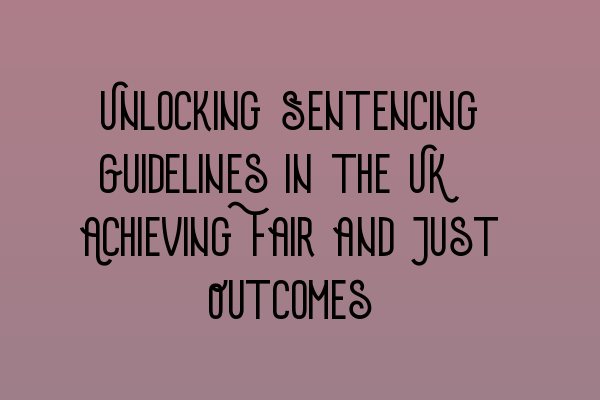Unlocking Sentencing Guidelines in the UK: Achieving Fair and Just Outcomes
As criminal law practitioners in the UK, our ultimate aim is to ensure fair and just outcomes for our clients. This requires a deep understanding of the sentencing guidelines, which play a crucial role in determining the appropriate punishment for a wide range of criminal offenses.
The sentencing guidelines provide a framework for judges and magistrates to follow when sentencing an offender. They take into account the seriousness of the offense, the harm caused, the culpability of the offender, and any mitigating or aggravating factors. By adhering to these guidelines, the courts strive to ensure consistency and transparency in the sentencing process.
Why are Sentencing Guidelines Important?
Sentencing guidelines are essential for promoting fairness and ensuring that similar offenses receive similar punishments. They also help to prevent any potential bias or prejudice in the sentencing process. Understanding these guidelines is therefore crucial for both criminal law practitioners and defendants.
By having a comprehensive knowledge of the guidelines, practitioners can effectively advocate for their clients, presenting compelling arguments based on relevant precedents and statutory provisions. This can significantly impact the outcome of a case.
For defendants, having an understanding of the sentencing guidelines allows them to make informed decisions during plea bargaining and sentencing hearings. They can assess the potential consequences and make more informed choices.
Unlocking the Sentencing Guidelines: A Step-by-Step Approach
1. Familiarize yourself with the Offense Category
The first step in understanding the sentencing guidelines is to determine the offense category. Offenses are typically classified into one of four categories: Category 1, Category 2, Category 3, or Category 4. Each category has its own range of possible sentences based on the seriousness of the offense.
2. Assess the Culpability and Harm Factors
Once the offense category has been determined, it is essential to assess the culpability and harm factors. Culpability refers to the level of blameworthiness of the offender, while harm refers to the severity of the consequences caused by the offense. These factors help to identify the starting point and the range of sentences within the offense category.
3. Consider the Presence of Aggravating or Mitigating Factors
In addition to the offense category, the presence of aggravating or mitigating factors can influence the sentencing outcome. Aggravating factors may increase the severity of the sentence, while mitigating factors may result in a more lenient punishment. Identifying and effectively presenting these factors to the court can have a significant impact on the sentence imposed.
Stay up-to-date with SQE Criminal Law & Practice Law UK
At SQE Criminal Law & Practice Law UK, we are dedicated to providing resources and information to help aspiring solicitors navigate the complex world of criminal law. Our SQE 1 Practice Exam Questions and SQE 1 Practice Mocks FLK1 FLK2 are designed to test your knowledge and prepare you for the SQE 1 examination.
To enhance your understanding of sentencing guidelines, we offer comprehensive SQE 2 Preparation Courses and SQE 1 Preparation Courses that cover all aspects of criminal law and practice.
Stay updated on the latest SRA SQE Exam Dates to ensure you are well-prepared and ready to achieve success in your journey towards becoming a qualified solicitor.
Unlocking the sentencing guidelines is a crucial step in achieving fair and just outcomes in criminal cases. By understanding the framework and effectively advocating for our clients, we can contribute to a more equitable criminal justice system.
